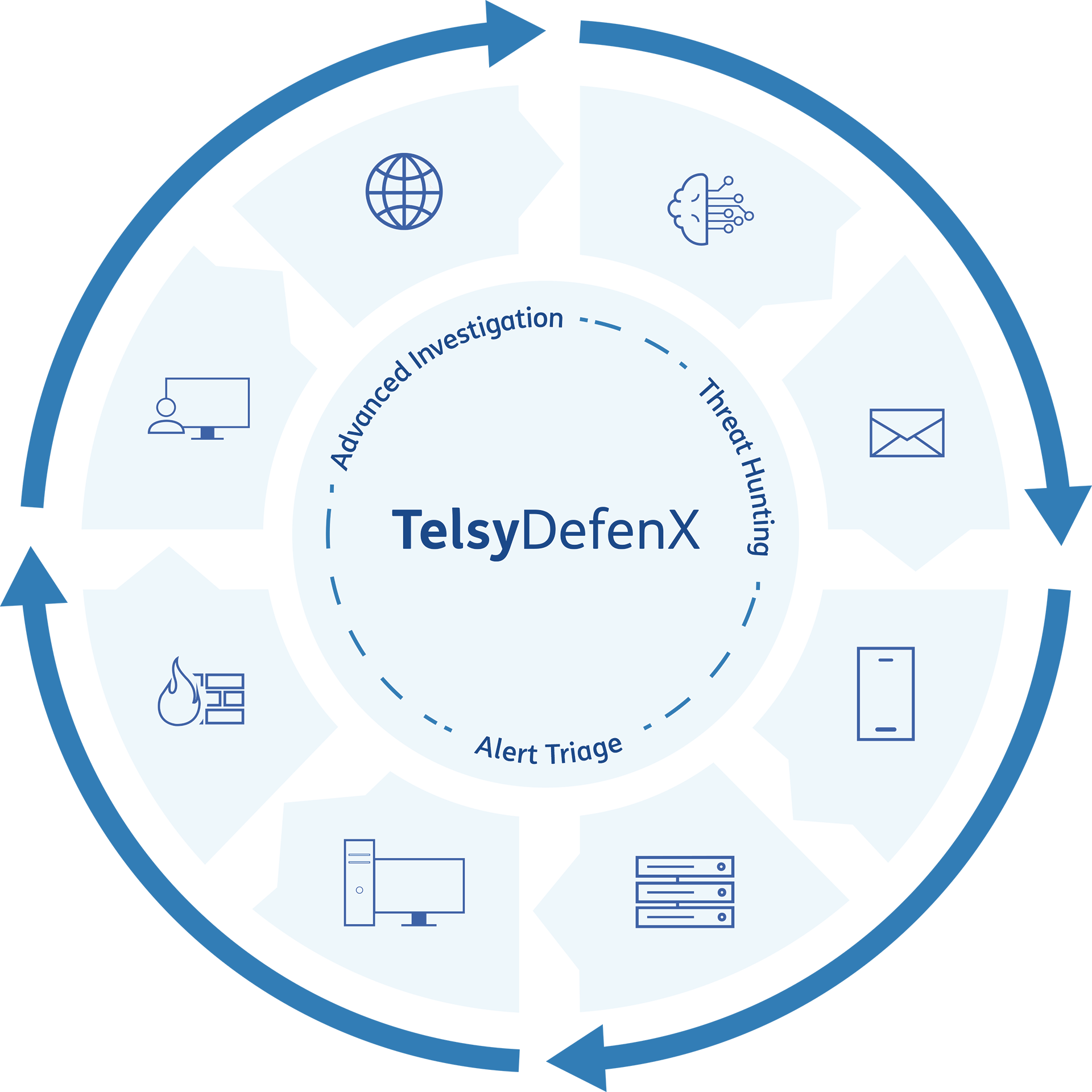eXtended Detection and Response (XDR)

The trend of cyber attacks shows a steady growth in terms of volume and sophistication.
Every organization, especially small and medium-sized ones, cannot cope with the critical issues of monitoring its security posture alone.
In an ever-changing cyber threat landscape, XDR’s systems aim to greatly improve the investigation and response time of security teams.
XDR (eXtended Detection and Response) systems are security solutions that go beyond “simple” Endpoint Protection and EDR (Endpoint Detection and Response) tools, integrating it with components to monitor e-mail gateways, cloud services, and access as well.
eXtended Detection and Response systems
An XDR is a SaaS tool that provides optimized holistic security by integrating data and security products into simplified solutions: is a multilevel security technology that safeguards the IT infrastructure.
As organizations increasingly face an ever-changing threat landscape and complex security challenges with employees in hybrid multi-cloud environments, the XDR represents a more efficient proactive solution.
Unlike endpoint detection and response (EDR) systems, XDRs broaden the scope of security by integrating protection across a wide range of products, including an organization’s endpoints, servers, cloud applications, email, and more.
An XDR combines prevention, detection, investigation, and response, providing visibility, analysis, alerts on related incidents and automated responses to improve data security and combat threats.
It collects and correlates data from multiple layers of security such as endpoints, apps, email, cloud, and networks, increasing visibility into an organization’s technology environment.
This enables security teams to detect, investigate, and respond to cyber threats quickly and effectively.
It is important to take advantage of XDR services that are professionally managed and integrated into a SOC, particularly in cases of small or medium-sized or unstructured companies, which often do not have substantial staff or infrastructure capabilities to properly manage the security of their equipment.
In fact, a managed and integrated service in a SOC eases the burden of operational activities associated with monitoring, detecting, and responding to cyber-attacks and significantly reduces the expenses associated with technology management, allowing companies to focus on their core “day-to-day” activities.
How does an XDR work?
The XDR is basically a consolidation of tools and data and represents a major step forward in enterprise security capabilities.
Because the XDR has access to raw data collected in the environment, it can detect malicious actors using legitimate software to gain access to the system (something that security event and information management software, or SIEM, is often unable to do).
 XDR performs automated analysis and correlation of activity data, enabling security teams to contain threats more effectively.
XDR performs automated analysis and correlation of activity data, enabling security teams to contain threats more effectively.
It is, for example, able to cover network detections, lateral movements, anomalous connections, beacons, exfiltration, and distribution of malicious artifacts.
Similar to EDR, XDR responds to the threat to contain and remove it.
However, the higher level of data collection and integration with the XDR’s environment enables a more effective response to the targeted resource.
XDR platforms provide the holistic visibility and context that security analysts need to respond to threats in a targeted and effective manner.
This tailored response helps contain not only the threat itself, but also the impact of the response on systems, for example by reducing downtime on critical servers.
XDR consists of three operational elements: telemetry and data analysis, detection, and response.
Telemetry and data analysis
XDR monitors and collects data across multiple layers of security, including endpoint, network, server, and cloud.
Data analytics is used to correlate the context of thousands of alerts from these layers in order to surface fewer high-priority alerts, helping to avoid overloading security teams.
Detection
XDR’s superior visibility allows it to screen alerts and flags that require a response.
The same visibility allows the creation of bases for comparison of normal behavior within an environment to enable the detection of threats that make the best use of software, ports, and protocols and to investigate the source of the threat to prevent it from affecting other parts of the system.
Response
Just like EDR, XDR has the ability to contain and remove detected threats as well as update security policies to prevent similar breaches from recurring.
However, unlike EDR, which performs this function only on endpoints and workloads, XDR goes beyond endpoint protection to respond to threats at all security control points it touches, from container security to networks and servers.
In fact, while EDR focuses on endpoints, XDR broadens the scope by focusing on various security control points to detect threats more quickly using in-depth analysis and automation.
XDR vs. EDR
XDR represents the evolution of detection and response beyond the current single-carrier solution-specific approach.
Clearly, endpoint detection and response (EDR) it’s still extremely valuable.
However, despite the depth of its capability, EDR is limited because it can only examine and respond to threats on managed endpoints.

This limits the scope of threats that can be detected as well as the view of who and what has been impacted, limiting the effectiveness of the response within the SOC.
Similarly, the expertise of Network Traffic Analysis tools is limited to the network and network segments being monitored and tends to generate a large amount of logs.
The correlation between network alerts and other activity data is critical to make sense of and increase the value derived from the network alerts themselves.
XDR systems thus serve as an alternative to solutions limited to only one security layer or capable of performing only event correlation without response, acting as the evolution of solutions such as Endpoint Detection and Response and Network Traffic Analysis.
Although still useful, those tools tend to generate higher volumes of alerts, but require more time to investigate and respond to events and more maintenance and management.
Instead, an XDR system consolidates the tools and enables security teams to work more effectively and efficiently.
Relying on an XDR technology means creating a security advantage by improving detection and response capabilities and unifying visibility and control at the endpoint, network, and cloud levels.
By linking data from different types of security solutions, threat visibility is improved and the time to detect and respond to attacks is reduced.
In fact, XDRs facilitate advanced investigation and threat detection capabilities across multiple domains from a single console.
TelsyDefenX: XDR managed service
TelsyDefenX is the right service for any organization seeking a specialized cybersecurity partner for a centralized, correlated monitoring, investigation and response service for its ICT infrastructure, an all-in-one solution that is simple to implement and has dedicated end-to-end support.
 It is a managed service that leverages eXtended Detection and Response (XDR) technologies by integrating them on Telsy’s SOC to provide security and protection against cyber threats and related hazards, supporting the organization’s dedicated cyber defense technical staff in their activities.
It is a managed service that leverages eXtended Detection and Response (XDR) technologies by integrating them on Telsy’s SOC to provide security and protection against cyber threats and related hazards, supporting the organization’s dedicated cyber defense technical staff in their activities.
TelsyDefenX provides customers with a managed service for identification, investigation, protection, and extended response that, through the collection and correlation of information from email, PdL, server, cloud, mobile, and network, enables a comprehensive view of organizations’ ICT infrastructure, accelerating investigation processes and streamlining monitoring and response activities by Telsy’s iSOC.
The added value of the solution lies in the customer coaching and support services in the onboarding & start-up service phases, along with the (24H operative) alert management service and threat investigation & reporting functions that we deliver through our SOC.
TelsyDefenX is designed for those fearing a cyber incident or data breach, especially if they are using a multitude of fragmented and unintegrated protection solutions that they cannot manage on their own, due in part to a shortage of dedicated staff resources.
Why TelsyDefenX
TelsyDefenX is an all-in-one solution that transcends vertical defense models with a centralized and integrated approach with dedicated end-to-end support.
Telsy’s expertise ensures side-by-side support from our SOC cybersecurity specialists, with 24/7 alert monitoring, proactive anomaly management, and support in the event of cyber incidents.
In addition, advanced and extensive protection is provided by combining human intelligence with technological intelligence, effectively protecting against hacker attacks of different nature, including ransomware, phishing, and BEC towards PdL, servers, email, cloud, network, and mobile devices.
Download TelsyDefenX brochure.
Learn more about this and other Managed Detection & Response solutions from Telsy.
